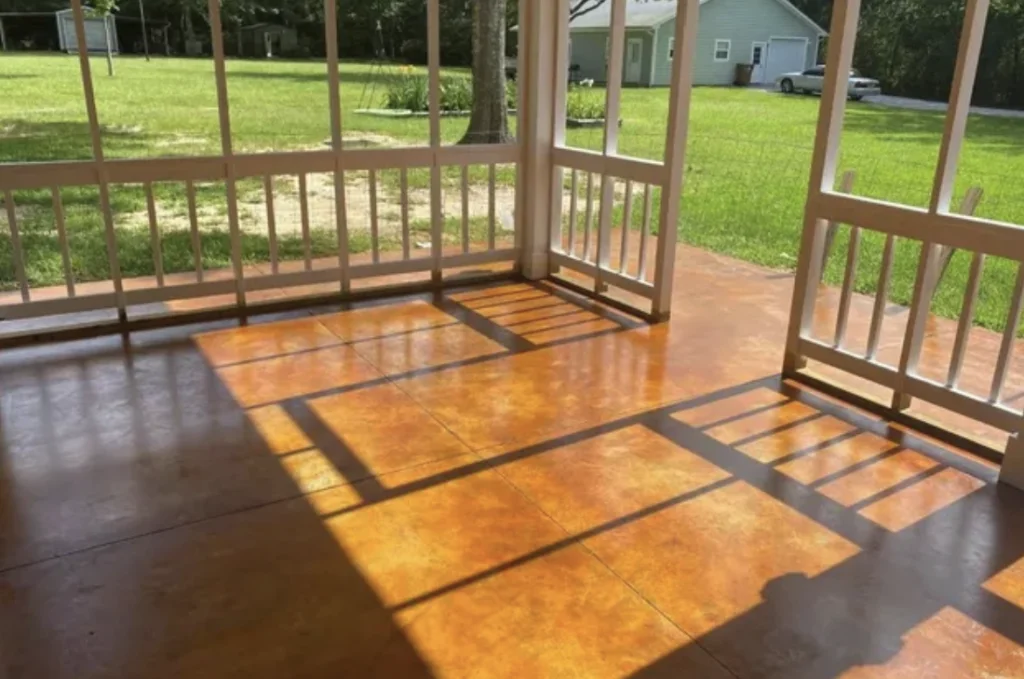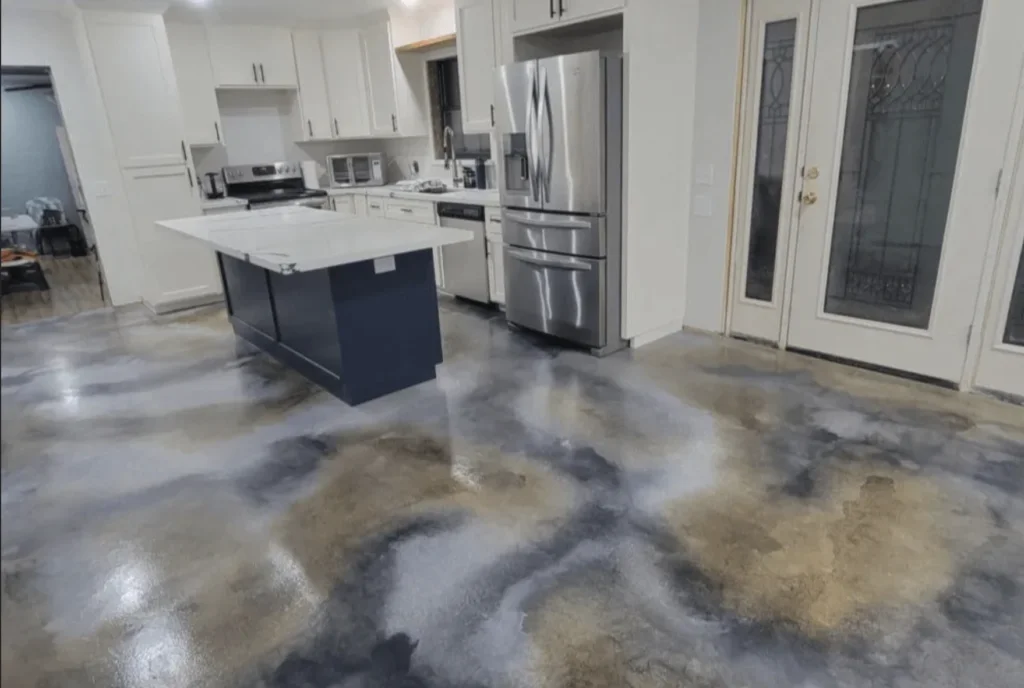Achieving consistent, vibrant colors in decorative concrete is one of the top priorities for concrete flooring specialists. Yet, final colors can sometimes differ from expectations, leaving both contractors and clients disappointed. These variations happen due to many factors, including the concrete batch composition, mixing practices, and environmental influences. Understanding why these variations occur and how to avoid them helps contractors communicate effectively with clients and improve their finished projects.
In this guide, we’ll walk through each stage of the decorative concrete process—from selecting ingredients to the finishing touches—to help you achieve richer, more uniform colors.
The journey to achieve rich, vibrant colors in decorative concrete starts with understanding and managing several factors that affect the final outcome. A well-prepared contractor knows how each stage, from material selection to moisture control, can influence the color, helping to deliver the results clients envision. Let’s explore the crucial steps in this process to create beautiful, lasting colors in decorative concrete.
Understanding Color in Decorative Concrete

Concrete color variations are common, but understanding the underlying causes can help you achieve better consistency. Concrete color depends on many factors, such as the ingredients used, moisture levels, finishing techniques, and the quality of pigments. When these are managed carefully, you can create a more predictable and appealing result.
Importance of Color Consistency
Consistency in concrete color is vital for aesthetic appeal, especially in high-visibility projects. Without proper attention, unintended color variations can detract from the design, requiring costly adjustments and potentially affecting client satisfaction.
Factors That Affect Concrete Color
Every stage of the concrete preparation and pouring process plays a role in determining the final color. Some of the most important factors include batch composition, aggregate selection, water ratios, and curing practices.
Before You Pour: Preparation Essentials
Proper preparation lays the groundwork for a uniform color. Ensuring the site is ready before you pour can help prevent issues down the road.
Site Preparation and Drainage
Site drainage impacts moisture levels, which can lead to blotchy or uneven color if not managed correctly. Without adequate drainage, water can seep into the slab, creating areas with more intense or lighter hues.
Importance of Vapor Retarders
Using a vapor retarder can help reduce uneven drying by minimizing the transfer of moisture from the ground to the concrete. This precaution helps to prevent unwanted discoloration due to moisture fluctuations.
The Concrete Batch: Where Color Begins

The color consistency of your concrete starts in the batching stage. Following best practices when creating the mix will help set a strong foundation for uniform color.
Key Ingredients in Concrete Mix
Concrete is made from a blend of Portland cement, aggregates, admixtures, and water. For the best color results, ensure uniformity in the materials and consistency in the ratios across batches.
Importance of Uniformity in Materials
Using the same supplier for all materials throughout the project reduces the likelihood of color variation. Any change in material source or composition can subtly alter the final hue.
Water-to-Cement Ratios and Color Consistency
The amount of water in the mix significantly affects the final color. Lower water-to-cement ratios create deeper, richer tones, while higher ratios yield lighter shades. By keeping this ratio consistent, you’ll achieve a more uniform color across the project.
Impact of Aggregates on Final Color
Aggregates in concrete play a subtle yet impactful role in color.
Aggregate Types and Their Color Influence
Different aggregates can give the concrete a slight tint. For instance, white sand produces a different shade than coarser, colored aggregates. Choose aggregates that complement your desired color outcome.
Selecting Non-Reactive Aggregates
Ensure aggregates are non-reactive to avoid interference with the water absorption process. Reactive aggregates can cause discoloration and lead to unintended shade variations.
Admixtures and Their Effects on Color
Admixtures can alter the drying time or color of concrete, so use them with caution.
Avoiding Discoloration
Some admixtures, like calcium chloride, can cause discoloration in colored concrete. Opt for admixtures specifically designed for colored concrete to avoid this risk.
Efflorescence Prevention
Efflorescence, or the appearance of white mineral deposits, can be more noticeable on colored concrete. Avoid admixtures that promote this effect to maintain clean, vibrant colors.
Pigments: Choosing the Right Color Additives

Pigments are an essential tool for creating specific colors in concrete. Selecting the right type and applying it correctly is key to achieving a consistent look.
Natural vs. Synthetic Pigments
Both natural and synthetic pigments can be used, though they have different effects on color durability. Synthetic pigments often provide a wider range of colors and more vibrant results.
Tips for Mixing Pigments
Always stir liquid pigments before adding them to the batch to prevent settling. When pigments are mixed evenly, it reduces the risk of color blotches and provides a uniform appearance.
Surface Considerations for Colored Concrete
How you handle the concrete during placement affects its final color.
Best Placement Practices
Place each concrete batch as close to its final position as possible. Moving concrete around too much requires extra water, which can dilute the color.
Minimizing Excess Water Use
Keeping tools and surfaces as dry as possible helps maintain color depth. Avoid adding water to the surface once the concrete is placed, as it can lighten the color and create a washed-out appearance.
Finishing Techniques for Consistent Color
The finishing process is critical to the final look of colored concrete.
Avoiding Over-Troweling
Excessive troweling can lead to dark spots or inconsistent colors. If possible, use a float, screed, or broom finish to create an even color.
Recommended Tools and Techniques
Using metal tools sparingly can prevent “burns” or dark streaks. Opt for plastic tools or techniques that limit friction to achieve smoother, more even color distribution.
Curing Methods for Vibrant Color Retention
Curing compounds help retain moisture and promote uniform drying, which are essential for even color.
Curing Compounds and Their Benefits
Specialized curing compounds are designed for colored concrete, reducing the chances of efflorescence and color inconsistencies.
Avoiding “Sheet” Style Curing Blankets
Curing blankets can trap moisture unevenly and create splotches. Instead, opt for spray-on curing compounds that allow even moisture retention.
The Role of Moisture in Color Development

Moisture control from start to finish is crucial for consistent color.
Importance of Consistent Moisture Distribution
Maintaining even moisture levels across the slab helps to create uniform colors. Proper curing compounds and placement techniques aid in this.
How Curing Compounds Affect Moisture
Curing compounds can lock in moisture, reducing the risk of uneven drying and promoting a consistent finish. Use products recommended for colored concrete for optimal results.
Testing Moisture Levels for Color Uniformity
Testing the slab’s moisture content throughout the curing process ensures the best results.
ASTM Standard Testing
ASTM standards for concrete moisture testing help you monitor levels and adjust the process as needed. It ensures that the slab is not only visually consistent but also durable.
Using Rapid RH® Testing
Rapid RH® sensors allow you to easily monitor internal moisture, ensuring that drying rates remain even. This test is invaluable for preserving uniform color and overall slab quality.
Conclusion
Achieving vibrant, consistent colors in decorative concrete requires a careful balance of ingredients, techniques, and moisture control. By understanding each step and its effect on color, contractors can create visually stunning, durable, and consistent concrete floors that meet and exceed client expectations.
FAQs
Can weather affect concrete color?
Yes, high humidity or extreme temperatures can impact drying time and color consistency.
How do you prevent blotching on colored concrete?
Controlling moisture levels and using the right curing compounds helps prevent blotches.
Is it better to use natural or synthetic pigments?
Both work well, but synthetic pigments offer a broader color range and greater vibrancy.
How does aggregate color affect the final concrete color?
Different aggregate types can subtly tint the final color, so choose aggregates based on your desired outcome.
What’s the best way to test concrete moisture?
Using ASTM standards with Rapid RH® testing ensures accurate results and helps maintain color consistency.
